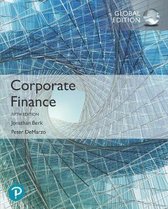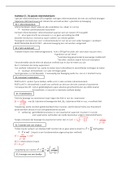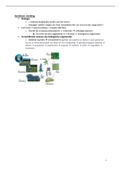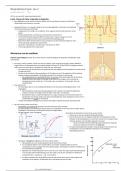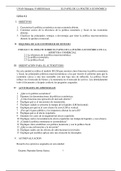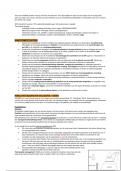CH25: Leasing
25.1: The basics of leasing
A lease is a contract between two parties: the lessee and the lessor. The lessor provides the
right-to-use of the asset, it is the owner of the asset. The lessee is liable for the periodic
payments in exchange for the right to use the asset, provides the payments.
Difference between this and renting is that at the end of the lease, you have the right to
buy the asset.
Three types of leases:
1. Sales-type lease
The lessor is also the producer. The advantage is that they can take control over all the
processes. A sales-type lease is for example the lease of a car from Toyota
2. Direct lease
The lessor is the firm specialized in leasing. For example, a firm that lease cares from all
manufactures.
3. Sale and lease back
The lessor is the buyer. For example, you sell your car to the lease company and lease it back.
The lessor is you again, but you are not the owner of it.
End-of-term lease options
There are different leases depending on the price to pay for the asset at the end:
- Fair Market Value (FMV) lease: its fair market value (residual value)
- $1 out lease. You pay $1 and get the asset
- Fixed price lease: a fixed price that is set upfront in the lease contract, similar to a call-
contract
- Fair market value cap lease: the minimum of its fair market value and a fixed price or
‘cap’. This is similar to a debt contract.
In a PCM there are two options. They can either buy the asset and then use it, or they can lease
the asset and when the lease terms ended buy the asset.
In a perfect capital market, the cost of leasing and then purchasing the asset is equivalent to the
cost of borrowing to purchase the asset
If PV (lease) > Purchase price – PV (residuals), then we are going for buying instead of leasing.
This is in PCM
Purchase Price = PV (Lease Payments) + PV (Residual Value)
, 25.2: Accounting, Tax, and Legal Consequences of Leasing
The effect on the income statement changes depending on the lease:
Operating lease: if the lease is similar to rent. Lease payment is reported as an expense. You are
not paying a lot of the asset. It is also an operation lease if the duration of the lease is short in
comparison to the asset.
Capital/finance lease: if the lease is similar to a levered acquisition. It is not an expense; it is a
deducting in liabilities and cash. The assets acquired is listed on the balance sheet, and the
lessee incurs depreciation expenses for the asset.
Example: I leased a car worth $24.000 for 20 years with a one-out lease with payments
equal to $101 per month. This is a capital lease because the value of the monthly payments is
way more than worth of the care.
Accounting
For any lease with term greater than 12 months or an asset with significant value:
- The PV of future lease payments are included in liabilities
- The asst is included in the balance sheet
Taxes
True-tax lease: if the lease is similar to a rent
- The lessor deducts the depreciation and treats it as revenue
Non-tax lease: if the lease is similar to a levered acquisition
- The lessee deducts the depreciation
Bankruptcy
A judge decides if the lease is:
True lease: if the lease is similar to a rent
- The lessor receives the asset unless all pending payments are honoured
Security interest: if the lease is similar to a levered acquisition
- The lessor becomes a regular secured debtholder
25.3: The Leasing Decision
The lease
payment must be
done at the
beginning of the
year.
You should think
that leasing is
better because it
cost less than
buying.
25.1: The basics of leasing
A lease is a contract between two parties: the lessee and the lessor. The lessor provides the
right-to-use of the asset, it is the owner of the asset. The lessee is liable for the periodic
payments in exchange for the right to use the asset, provides the payments.
Difference between this and renting is that at the end of the lease, you have the right to
buy the asset.
Three types of leases:
1. Sales-type lease
The lessor is also the producer. The advantage is that they can take control over all the
processes. A sales-type lease is for example the lease of a car from Toyota
2. Direct lease
The lessor is the firm specialized in leasing. For example, a firm that lease cares from all
manufactures.
3. Sale and lease back
The lessor is the buyer. For example, you sell your car to the lease company and lease it back.
The lessor is you again, but you are not the owner of it.
End-of-term lease options
There are different leases depending on the price to pay for the asset at the end:
- Fair Market Value (FMV) lease: its fair market value (residual value)
- $1 out lease. You pay $1 and get the asset
- Fixed price lease: a fixed price that is set upfront in the lease contract, similar to a call-
contract
- Fair market value cap lease: the minimum of its fair market value and a fixed price or
‘cap’. This is similar to a debt contract.
In a PCM there are two options. They can either buy the asset and then use it, or they can lease
the asset and when the lease terms ended buy the asset.
In a perfect capital market, the cost of leasing and then purchasing the asset is equivalent to the
cost of borrowing to purchase the asset
If PV (lease) > Purchase price – PV (residuals), then we are going for buying instead of leasing.
This is in PCM
Purchase Price = PV (Lease Payments) + PV (Residual Value)
, 25.2: Accounting, Tax, and Legal Consequences of Leasing
The effect on the income statement changes depending on the lease:
Operating lease: if the lease is similar to rent. Lease payment is reported as an expense. You are
not paying a lot of the asset. It is also an operation lease if the duration of the lease is short in
comparison to the asset.
Capital/finance lease: if the lease is similar to a levered acquisition. It is not an expense; it is a
deducting in liabilities and cash. The assets acquired is listed on the balance sheet, and the
lessee incurs depreciation expenses for the asset.
Example: I leased a car worth $24.000 for 20 years with a one-out lease with payments
equal to $101 per month. This is a capital lease because the value of the monthly payments is
way more than worth of the care.
Accounting
For any lease with term greater than 12 months or an asset with significant value:
- The PV of future lease payments are included in liabilities
- The asst is included in the balance sheet
Taxes
True-tax lease: if the lease is similar to a rent
- The lessor deducts the depreciation and treats it as revenue
Non-tax lease: if the lease is similar to a levered acquisition
- The lessee deducts the depreciation
Bankruptcy
A judge decides if the lease is:
True lease: if the lease is similar to a rent
- The lessor receives the asset unless all pending payments are honoured
Security interest: if the lease is similar to a levered acquisition
- The lessor becomes a regular secured debtholder
25.3: The Leasing Decision
The lease
payment must be
done at the
beginning of the
year.
You should think
that leasing is
better because it
cost less than
buying.

